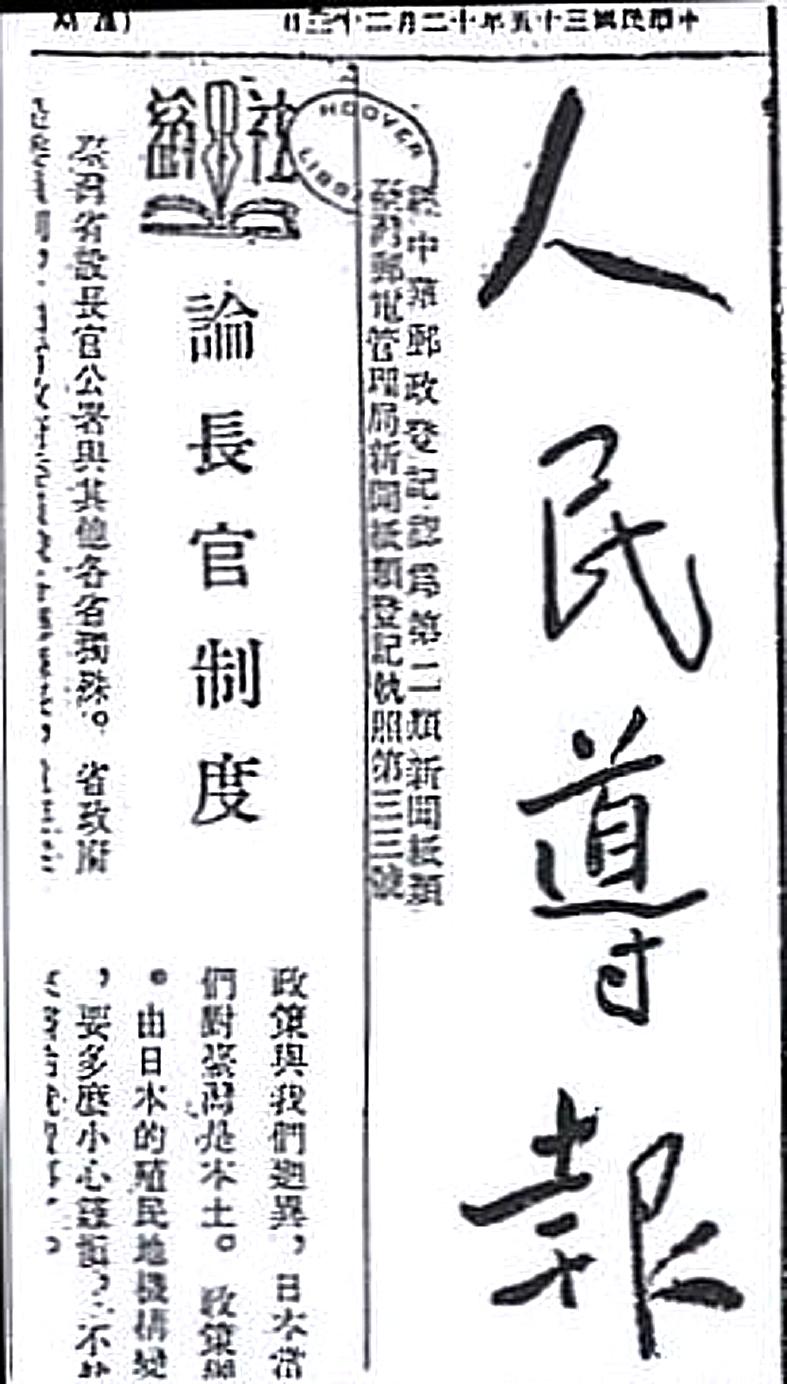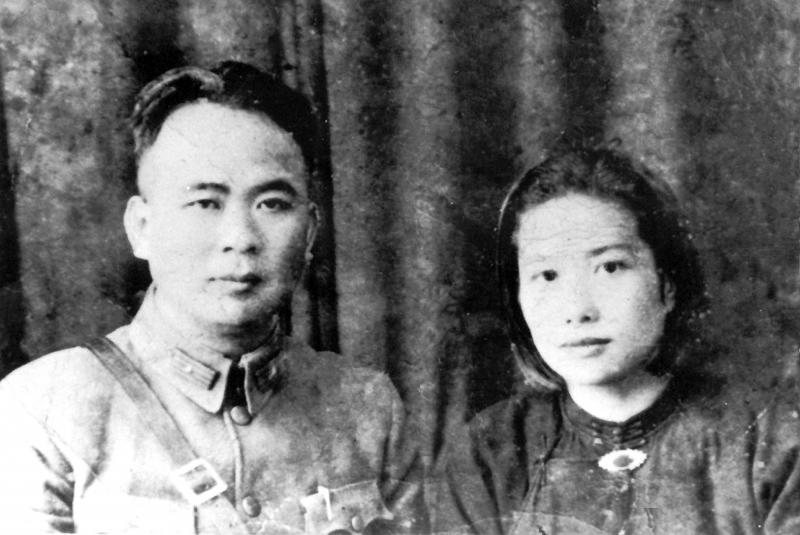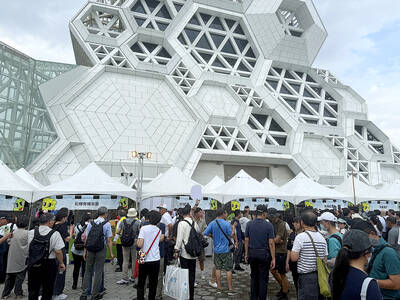March 01 to March 07
There was only one Taiwanese department head in Taiwan’s first post-World War II provincial government: Sung Fei-ju (宋斐如), who served as deputy director of the department of education. Sung, who lived in China for over two decades, had close ties with the Chinese Nationalist Party (KMT) and was also allowed to start his own newspaper, the People’s News-Leader (人民導報).
Aside from Sung, only a handful of Taiwanese held significant positions in the government, almost all of them banshan (半山, half mountain) like him. The term refers to those who moved to China and returned to Taiwan after World War II.
.jpg)
Photo courtesy of Lin Hsiao-feng
Sung’s standing, however, did not save his neck during the 228 Incident, an anti-government uprising on Feb. 28 1947 that was brutally suppressed. He was dragged away from his home on March 11 and never seen again.
Lin Cheng-te’s (林政德) book Banshan and 228 (半山與二二八) explores the various roles these banshan took up before, during and after the incident. Despite their allegiance to the government, they tried to help their people in their own way, and in Sung’s case, paid the ultimate price for it.
HOPEFUL RETURN

Photo courtesy of Wikimedia Commons
As World War II neared its end, the KMT set up a committee led by future governor-general Chen Yi (陳儀) to make plans for the takeover and rule of Taiwan. Several founding members were banshan, and Sung joined the following year. They flew to Taipei on Oct. 5, 1945, set up headquarters and began working with local elites such as Lin Hsien-tang (林獻堂) to prepare for the Japanese governor-general’s formal surrender on Oct. 25.
Sung was one of many Taiwanese who, unsatisfied with Japanese rule, turned to the “motherland” of China. He moved to Beijing in 1922 to attend university, and from 1932 to 1935 served as adviser and tutor to the powerful warlord Feng Yuxiang (馮玉祥) and his family. Sung penned numerous papers and launched a publication to help the government better understand and resist Japanese aggression, and was recognized for his efforts.
Sung was in favor of the KMT taking over Taiwan from Japan, and was initially confident that this would liberate Taiwanese from the shackles of colonial oppression. With fellow banshan Lee You-pang (李友邦), Sung formed the Taiwan Revolution Alliance (台灣革命聯盟) in 1941 to promote the idea among Taiwanese in China, many of whom felt discriminated against since they were often treated as Japanese. Until the end of the war, Sung devoted his time to training personnel to help rebuild and govern Taiwan.

Photo courtesy of Wikimedia Commons
Sung continued his mission of education in his new position upon arriving in Taiwan, and his People’s News-Leader aimed to “dispel past misbeliefs, promote the culture of the motherland, communicate both national and international current events and ideas, promulgate government’s policies, report on social issues and help build a new Taiwan based on the Three Principles of the People.”
Disillusion toward the KMT came quickly, and soon the paper was frequently criticizing Chen Yi’s policies and also reporting on sensitive topics regarding the Chinese Civil War. An irate Chen forced Sung to either quit his government job or step down from the paper. Sung chose the latter, but was reinstated a few months later. Nine days before the 228 Incident broke out, Sung was removed from his post on the grounds that public servants could not run a newspaper.
Sung’s colleagues advised him to flee to Hong Kong after the uprising started, but he stayed to help the paper report on the events. On March 8, the authorities shut down the paper.
Sung did not participate in the incident in any other way, so why was he executed? Due to his relentless criticism of the government and some of the paper’s past rhetoric (such as using “communist army” instead of “communist bandits”), secret agents framed Sung as the “Communist Party leader of Taiwan,” which amounted to a death sentence.
The tragedy doesn’t end there. Sung’s wife, Chu Yen-hua (區嚴華), was arrested in September for harboring a wanted couple and helping them escape Taiwan. She was executed in January 1950.
TRAGIC COUPLE
Lee You-pang also hated the Japanese. He fled Taiwan after launching several student attacks on Japanese police stations and continued his anti-Japanese crusade in China after graduating from the Whampoa Military Academy.
He returned home in December 1945 and was appointed as leader of the Taiwan branch of the Three Principles Youth Group (三民主義青年團). But despite his contributions to the war, Chen Yi suddenly disbanded his Taiwan Militia (台灣義勇隊) without discharge orders or pension.
Perhaps Lee was too naive. He once openly stated that he hoped to recruit as many members into the Youth Group to “reform” the KMT, which he thought was too corrupt. This obviously did not sit well with the top brass.
When the 228 Incident broke out, Chen Yi asked Lee to broadcast a plea for the people to stop fighting, but Lee refused and criticized Chen: “I’ve been telling you this whole time to quit being corrupt and rule fairly, as that is the only way to win the support and hearts of the people. You didn’t listen, and now everything has spiraled out of control. How can I stop this chaos by just uttering a few sentences?”
BESEECHING CHIANG CHING-KUO
Lee was arrested on March 10, a day before Sung disappeared. He was taken to Nanjing, where the Three Principles Youth Group was headquartered. Lee’s wife, Yen Hsiu-feng (嚴秀峰), traveled to Nanjing and after a month had an audience with Chiang Ching-kuo (蔣經國), the son of KMT leader Chiang Kai-shek (蔣介石) and an officer in the Youth Group’s central command.
Chiang told her Lee was charged with inciting Taiwan’s Youth Group members to riot and harboring communists. Yen pleaded her case, and a subsequent government investigation showed her versions of the events to be true. Lee was released a few months later, narrowly escaping death.
Lin writes that this showed that despite just holding a minor position, Chiang already wielded considerable influence, and also that he was less stubborn than his father.
However, trouble didn’t end for the family there. In February 1950, Yen was sentenced to 15 years in prison for failing to report a communist, while Lee was arrested the following year and charged with harboring communists and attempting to overthrow the government. He was executed on April 22, 1952.
Taiwan in Time, a column about Taiwan’s history that is published every Sunday, spotlights important or interesting events around the nation that either have anniversaries this week or are tied to current events.

Following the shock complete failure of all the recall votes against Chinese Nationalist Party (KMT) lawmakers on July 26, pan-blue supporters and the Chinese Communist Party (CCP) were giddy with victory. A notable exception was KMT Chairman Eric Chu (朱立倫), who knew better. At a press conference on July 29, he bowed deeply in gratitude to the voters and said the recalls were “not about which party won or lost, but were a great victory for the Taiwanese voters.” The entire recall process was a disaster for both the KMT and the Democratic Progressive Party (DPP). The only bright spot for

Water management is one of the most powerful forces shaping modern Taiwan’s landscapes and politics. Many of Taiwan’s township and county boundaries are defined by watersheds. The current course of the mighty Jhuoshuei River (濁水溪) was largely established by Japanese embankment building during the 1918-1923 period. Taoyuan is dotted with ponds constructed by settlers from China during the Qing period. Countless local civic actions have been driven by opposition to water projects. Last week something like 2,600mm of rain fell on southern Taiwan in seven days, peaking at over 2,800mm in Duona (多納) in Kaohsiung’s Maolin District (茂林), according to

Aug. 11 to Aug. 17 Those who never heard of architect Hsiu Tse-lan (修澤蘭) must have seen her work — on the reverse of the NT$100 bill is the Yangmingshan Zhongshan Hall (陽明山中山樓). Then-president Chiang Kai-shek (蔣介石) reportedly hand-picked her for the job and gave her just 13 months to complete it in time for the centennial of Republic of China founder Sun Yat-sen’s birth on Nov. 12, 1966. Another landmark project is Garden City (花園新城) in New Taipei City’s Sindian District (新店) — Taiwan’s first mountainside planned community, which Hsiu initiated in 1968. She was involved in every stage, from selecting

The latest edition of the Japan-Taiwan Fruit Festival took place in Kaohsiung on July 26 and 27. During the weekend, the dockside in front of the iconic Music Center was full of food stalls, and a stage welcomed performers. After the French-themed festival earlier in the summer, this is another example of Kaohsiung’s efforts to make the city more international. The event was originally initiated by the Japan-Taiwan Exchange Association in 2022. The goal was “to commemorate [the association’s] 50th anniversary and further strengthen the longstanding friendship between Japan and Taiwan,” says Kaohsiung Director-General of International Affairs Chang Yen-ching (張硯卿). “The first two editions